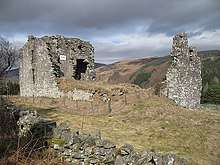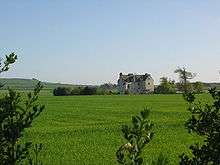Gideon Murray
Gideon Murray of Elibank (d. 1621), Scottish courtier and landowner.

Family
Gideon Murray was a son of Sir Andrew Murray of Black Barony, Peebleshire, and Grizzel Beaton, a daughter of Sir John Beaton of Creich, Fife. He was a grandson of Isobel Hoppar.
In July 1595 his Margaret Murray sister married Robert Halkett, Laird of Pitfirrane, and there was a banquet in Edinburgh attended by Anne of Denmark. Their son James married the writer, Anne Murray, Lady Halkett.[1]
Career
He was educated at the University of Glasgow.
He was a prisoner in Edinburgh Castle in October 1585, and released with a caution of £5,000 Scots from his brother, James Murray of Blackbarony, to remain in Edinburgh.[2]
In July 1592 Murray was commanded to demolish the towers of Harden and Dryhope, belonging to Walter Scott of Harden, because Scott had taken part in the assault on Falkland Palace led by Francis Stewart, 5th Earl of Bothwell in June.[3]
Murray was appointed a border official in 1603, and a member of the Privy Council of Scotland in 1610. In 1612 he was made a Lord of Session as Lord Elibank.
Gideon Murray was the uncle of Sir Robert Kerr, Lord Rochester and Earl of Somerset, the favourite of King James. Somerset's influence led to the appointment of Murray as Treasurer Depute of Scotland.[4] The role involved management of the repairs to the royal castles and palaces in Scotland, as well as work on Glasgow Cathedral in 1620.[5]

In June 1614 he wrote to the king about silver mines in Scotland which were now proving profitable.[6]
To help finance the visit of King James to Scotland in 1617, Murray borrowed £66,666 Scots from William Dick, a merchant burgess of Edinburgh, and the advocate Alexander Morrison. He repaid them through tax receipts. A further £96,000 was sent from England, including some money from the privy purse. Preparations for the royal visit included repairs at Linlithgow Palace, the palace block at Edinburgh Castle, works at Stirling Castle, and fireworks at Edinburgh Castle and the masque and morris dance at Holyrood Palace on the king's birthday, 19 June.[7] King James gave particular instructions for the chapel in Holyroodhouse, and encouraged Gideon Murray to contract the London stonemason Nicholas Stone to design and supervise the decoration.[8]
In 1618 King James gave a gold basin which the burgh of Edinburgh had given to him the year before, with two gilt cups, one in the form of a salmon, from the burgh of Glasgow, a gold cup presented by Carlisle, with some valuable musk and ambergris, and an iron chest that had belonged to the Earl of Gowrie.[9]
In June 1620 he explained how a ban on the circulation of foreign coins in Scotland had damaged the economy.[10]
In 1621 James Stewart, Lord Ochiltree accused Murray of misusing public money, and this brought about a nervous breakdown and his death on 28 June 1621.[11]
He was buried at Holyrood Abbey in Edinburgh.
Castles and towers
Elibank Tower was sited on the Eliburn stream near Walkerburn. The L shaped building had two towers and two terraced gardens to the south and west, described as Italianate in inspiration. Murray also had a lodging in Edinburgh and another border home at Langshaw where there was another terraced garden.[12] At Ballencreiff in East Lothian, the hall ceiling had plaster ciphers of "SGM" and "DMP" for Sir Gideon Murray and his wife Dame Margaret Pentland, and the fetterlock and stars (mullets) from his heraldry.[13]
Marriage and children
The children of Gideon Murray and Margaret Pentland included:
- Patrick Murray, Lord Elibank.
- Agnes Murray, who married Sir Walter Scott of Harden in 1611. She became known as Muckle Mouthed Meg.
- Walter Murray of Livingstone (d. 1659), who married Elizabeth Pringle.
- William Murray, who was made Commissioner of the Customs in Scotland on 23 October 1618, at the same time his father was given silver plate previously gifted to the king.[14]
External links
References
- Annie I. Cameron, Calendar State Papers Scotland, vol. 11 (Edinburgh, 1936), p. 627.
- David Masson, Register of the Privy Council of Scotland: 1578-1585, vol. 3 (Edinburgh, 1880), p. 728.
- David Masson, Register of the Privy Council of Scotland, vol. 4 (Edinburgh, 1881), p. 769.
- Keith Brown, Noble Power in Scotland from the Reformation to the Revolution (Edinburgh, 2011), p. 203: John Spottiswood, History of the Church of Scotland, vol. 3 (Edinburgh, 1850), p. 214.
- HMC Mar & Kellie (London, 1904), pp. 90-1.
- James Maidment, Letters and State Papers During the Reign of King James the Sixth (Edinburgh, 1838), pp. 216-7.
- John Imrie & John Dunbar, Accounts of the Masters of Works, vol. 2 (Edinburgh, 1982), pp. xxxii-xxxiii, 84, 89-93: Julian Goodare, State and Society in Early Modern Scotland (Oxford, 1999), p. 130: W. MacNeill and P. MacNeill, 'The Scottish Progress of James VI', SHR, 75 (1996), pp. 47-50: John Spottiswoode, History of the Church of Scotland (Edinburgh, 1850), p. 239.
- David Masson, Register of the Privy Council of Scotland: 1613-1616, vol. 10 (Edinburgh, 1891), pp. 593-4.
- Robert Chambers, Domestic Annals of Scotland, vol. 1 (Edinburgh, 1858), p. 482.
- James Maidment, Letters and State Papers During the Reign of King James the Sixth (Edinburgh, 1838), pp. 328-9.
- Calderwood, vol. 7, p. 462.
- Marilyn Brown, Scotland's Lost Gardens (Edinburgh, 2012), pp. 160-4.
- Peter Laing Gillies, 'Ballencreiff, ELA & FNS Transactions, vol. 13 (2015), pp. 97-98, 110.
- James Maidment, Analecta Scotica (Edinburgh, 1834), pp. 52-53 & fn.